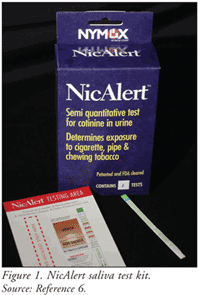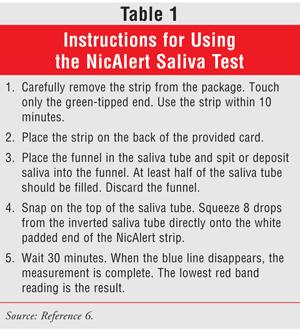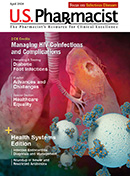US Pharm. 2009;34(7):36-38.
Tobacco use is the single most preventable cause of disease, disability, and death in the United States. About 20% of preventable deaths in the U.S. are tobacco-related, equating to approximately one-half million people per year. Tobacco use is associated with an elevated risk of cardiovascular disease, cancer, respiratory disorders, and other diseases, and it can interfere with the efficacy of medications.1,2 Approximately 438,000 people die prematurely from smoking or exposure to secondhand smoke; another 8.6 million have a serious illness as a consequence of smoking. For every person who dies from smoking, 20 more people suffer from at least one serious tobacco-related illness.2,3 Despite public awareness of these health dangers, tobacco use remains prevalent, with approximately 43.4 million U.S. adults smoking cigarettes. In the U.S., 23% of high school students currently smoke cigarettes; each day, approximately 4,000 youths between the ages of 12 and 17 years begin smoking and an estimated 1,200 children and adolescents become daily cigarette smokers.3,4
Annual health care expenditures attributable to cigarette smoking in the U.S. have been estimated at $96 billion in direct medical expenses and $97 billion in lost productivity. The total additional economic cost associated with cigarette smoking is approximately $7.18 per pack of cigarettes sold in the U.S.3 Clinical-practice guidelines recommend the consistent identification and documentation of tobacco users as the first step in clinical intervention.3,5
Although self-reported smoking status helps identify most smokers, data suggest that a fair number of patients--ranging from 1.4% in broadly based epidemiologic studies to as high as 35% in populations in which smoking is a known risk factor--self-report inaccurately owing to a variety of factors such as misunderstanding, intentional deception, embarrassment, denial, and shame.5 The measurement of cotinine--a primary metabolite of nicotine with a half-life of 16 to 18 hours that is detectable in urine, saliva, or serum--is a reliable method of determining use of or exposure to cigarettes or other tobacco products over a period of 2 to 3 days. Another method is expired carbon monoxide (CO) testing. CO, however, has a relatively short half-life of 4 hours, limiting its reliability and accuracy in detecting smokers. Additionally, CO testing cannot detect the use of smokeless tobacco products such as chew and snuff.
Even though cotinine measurement has not been used routinely in clinical settings, the validation of reported tobacco use may be clinically significant for smoking cessation clinics, research settings, pulmonary and pediatric clinics, and transplant-candidate selection. The NicAlert saliva test, a new diagnostic device that measures cotinine levels, could play a significant role in many home or research settings.5

NicAlert Saliva Test
Developed by Nymox Pharmaceutical Corporation, the NicAlert saliva test (FIGURE 1) is intended for in vitro diagnostic use. The test kit contains a funnel, a saliva tube, a snap-on top with a specialized filter, and an individually packaged NicAlert test strip in a sealed plastic pouch.6 Once the pouch is opened, the test strip should be used within 10 minutes. The strip should never be placed in the mouth; saliva should be deposited into the funnel and about eight drops of the deposited saliva placed directly on the NicAlert strip. Allow 30 minutes to elapse before reading the strip. See TABLE 1 for detailed patient instructions.

Efficacy
Montalto and Wells evaluated the the NicAlert saliva test as a rapid method for verifying an individual's self-reported smoking status versus liquid chromatography/mass spectrometry (LC/MS). The 172 patients, from a family practice/general medical setting, provided information about their smoking status and exposure to environmental tobacco smoke and supplied urine and saliva samples for analysis. Results demonstrated that cotinine levels in urine (LC/MS; 50-ng/mL cutoff) were comparable to levels in the saliva test. The saliva test strip had 99% sensitivity and 96% specificity. The NicAlert test also identified four patients who were reported as nonsmokers but later confirmed to be smokers by LC/MS.5
Cooke et al examined the accuracy and clinical usefulness of the NicAlert saliva test strips in 86 adults (41 smokers, 45 nonsmokers). Gas chromatography (GC) was used as the reference standard and saliva as the sample medium. Two saliva samples were collected simultaneously from each participant; one sample was tested using NicAlert strips and the other by GC analysis. Subjects with at least 10 ng/mL cotinine in their saliva (in both tests) were considered smokers. The NicAlert strips had 95% specificity (95% CI 89%-100%), 93% sensitivity (95% CI 85%-100%), a positive predictive value of 95% (95% CI 89%-100%), and a negative predictive value of 93% (95% CI 86%-100%). NicAlert saliva test strips were found to be valid and reliable for verifying smoking status.7
Conclusion
The NicAlert saliva test could potentially be used to test for tobacco use or exposure to second-hand (environmental) smoke. This test offers a cost-effective, convenient, and accurate way to monitor tobacco exposure. Parents who wish to monitor tobacco use, concerned family members, and health-policy insurers may find this test useful.8 For more information, visit Nymox Pharmaceutical Corporation at www.nymox.com.
REFERENCES
1. Centers for Disease Control and Prevention. Annual smoking-attributable mortality, years of potential life lost, and economic costs--United States, 1995-1999. MMWR. 2002;51:300-303.
2. Centers for Disease Control and Prevention. Tobacco-related mortality fact sheet.
www.cdc.gov/tobacco/data_
3. Fiore MC, Jaén CR, Baker TB, et al. Treating Tobacco Use and Dependence: 2008 Update. Clinical Practice Guideline. Rockville, MD: U.S. Department of Health and Human Services Public Health Service; May 2008.
4. Centers for Disease Control and Prevention. 27: Tobacco use. Healthy People 2010.www.healthypeople.gov/
5. Montalto NJ, Wells WO. Validation of self-reported smoking status using saliva cotinine: a rapid semiquantitative dipstick method. Cancer Epidemiol Biomarkers Prev. 2007;16:1858-1862.
6. NicAlert saliva test product insert. Hasbrouck Heights, NJ: Nymox Pharmaceutical Corporation.
7. Cooke F, Bullen C, Whittaker R, et al. Diagnostic accuracy of NicAlert cotinine test strips in saliva for verifying smoking status. Nicot Tob Res. 2008;10:607-612.
8. Nymox Pharmaceutical Corporation. NicAlert™: a simple and cost effective way to monitor exposure to tobacco products.
www.nymox.com/products/
To comment on this article, contact rdavidson@jobson.com.






